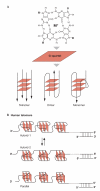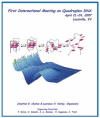Quartets in G-major. The First International Meeting on Quadruplex DNA
- PMID: 17901879
- PMCID: PMC2247389
- DOI: 10.1038/sj.embor.7401073
Quartets in G-major. The First International Meeting on Quadruplex DNA
Conflict of interest statement
Paula Bates is a consultant and shareholder for Antisoma PLC (London, UK).
Figures






References
-
- Alberti P, Bourdoncle A, Saccà B, Lacroix L, Mergny JL (2006) DNA nanomachines and nanostructures involving quadruplexes. Org Biomol Chem 4: 3383–3391 - PubMed
-
- Ambrus A, Chen D, Dai J, Jones RA, Yang D (2005) Solution structure of the biologically relevant G-quadruplex element in the human c-MYC promoter. implications for G-quadruplex stabilization. Biochem 44: 2048–2048 - PubMed
Publication types
MeSH terms
Substances
LinkOut - more resources
Full Text Sources

